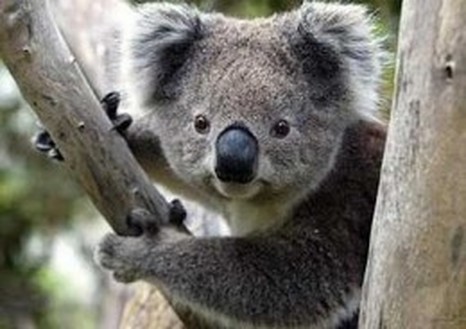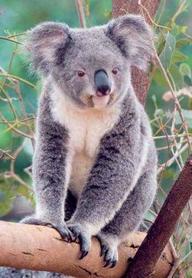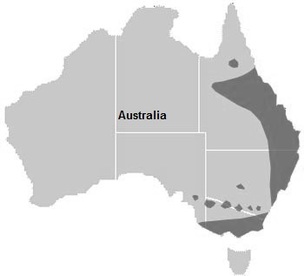KoalaPhascolarctos cinereus |

Custom Search
|
The name "koala" comes from the aboriginal dialect and means "no drink", which is consistent with the dietary habits of this animal, since almost all the fluid they drink comes from the eucalyptus tree leaves.
The scientific name derives from the Greek words "phaskolon" ("pocket") and "Arktos" ("bear") and the Latin word "cinereus" (gray color). The coat is soft, gray in the dorsal area and white in the ventral area of the body. The head is rounded and the ears are large and hairy. The nose is large, usually colored black and has no hair. Only the females have marsupial pouch. Koalas are arboreal animals and have nocturnal habits. Koalas are solitary animals. At best, they live near each other, but never in groups larger than 10 animals, most often consisting of several females of childbearing age and a dominant male, who controls his harem. Despite its weight (males weighing about 10 kg and females about 8 kg), they are excellent climbers. Koalas have a life expectancy of about 15 years. Koala Diet
They select new shoots and leaves from only 20 of the 350 Eucalyptus tree species existing in Australia. They also feed on the softer bark of these trees and soil, which provides them with various minerals they need. Given the poverty of their diet, koalas need many hours of sleep. An adult animal sleeps between 16 and 18 hours a day, the remainder being devoted almost exclusively to feeding. Koala Reproduction The mating season occurs from September to January. At this time, males mark the branches with odors from glands that they have in the chest. With these odors and emitting vocalizations (males emit sounds that resemble those of a pig) they try to attract females in estrous. Males fight each other and each one tries to keep a harem (a group of breeding females) during the mating season. The gestation period is 35 days, after which the baby (rarely twins) migrates to the marsupial pouch, where it remains breastfed for about seven months. Koala Females are one the few mothers in the wild who adopt orphaned cubs. The cub then moves to the back of the female, in which it clings for the first year of age. The transition from feeding on breast milk to eucalyptus leaves is made through the ingestion of pre-digested materials by the mother. Koala males reach sexual maturity at three to four years of age and females at two years old. Koala Conservation status and main threats Some years after the arrival of Europeans to Australia, it was fashionable to have a Koala skin as a trophy. Given their natural slowness, the Koalas were easy targets and even showed no fear of men, since they only knew the aborigines, who respected them as they respect all animals, strictly limiting hunting to a minimum. It is considered a Low risk / near threatened (by the International Union for Conservation of Nature). In the late nineteenth century, there were large populations, but deforestation, fires, disease and excessive hunting for sport and for the fur trade almost brought the species to extinction by the early twentieth century. During the last half century, thanks to the efforts for their conservation, populations have been recovering. At the moment the greatest danger for the Koalas are the loggers, which devastated large areas of forest for timber exploitation. Other causes are roadkill mortality, frequent during the night period in which Koalas are most active and moving, and the violent forest fires which have occurred in recent years. However the number of animals surveyed have increased in recent years, thanks to the protection that the Australian government has given to koalas, reintroducing animals into areas where they had disappeared, or where there were already few animals.
|
Scientific classification
Kingdom: Animalia Phylum: Chordata Class: Mammalia Infraclass: Marsupialia Order: Diprotodontia Family: Phascolarctidae Genus: Phascolarctos Species: P. cinereus |



